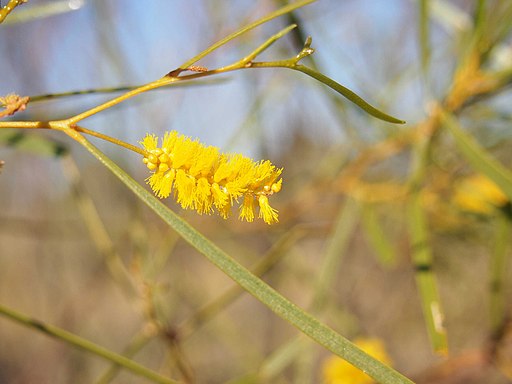Classification System: APG IV
Superregnum: Eukaryota
Regnum: Plantae
Cladus: Angiosperms
Cladus: Eudicots
Cladus: Core eudicots
Cladus: Rosids
Cladus: Eurosids I
Ordo: Fabales
Familia: Fabaceae
Subfamilia: Caesalpinioideae
Tribus: Acacieae
Genus: Acacia
Species: Acacia ancistrocarpa
Name
Acacia ancistrocarpa Maiden & Blakely, 1927
Synonyms
Racosperma ancistrocarpum (Maiden & Blakely) Pedley
Distribution
Native distribution areas:
Acacia ancistrocarpa
Continental: Australasia
Regional: Australia
Northern Territory, Queensland, Western Australia
References: Brummitt, R.K. 2001. TDWG – World Geographical Scheme for Recording Plant Distributions, 2nd Edition
References
Primary references
Maiden, J.H. & Blakely, W.F., 1927. Journal of the Royal Society of Western Australia 13:31, t. 21, figs. 1-6.
Links
Govaerts, R. et al. 2020. Acacia ancistrocarpa in Kew Science Plants of the World online. The Board of Trustees of the Royal Botanic Gardens, Kew. Published on the internet. Accessed: 2020 Jul 24. Reference page.
International Plant Names Index. 2019. Acacia ancistrocarpa. Published online. Accessed: Jul 24 2019.
Tropicos.org 2019. Acacia ancistrocarpa. Missouri Botanical Garden. Published on the internet. Accessed: 2019 Jul 24.
Hassler, M. Jul. Acacia ancistrocarpa. World Plants: Synonymic Checklists of the Vascular Plants of the World In: Roskovh, Y., Abucay, L., Orrell, T., Nicolson, D., Bailly, N., Kirk, P., Bourgoin, T., DeWalt, R.E., Decock, W., De Wever, A., Nieukerken, E. van, Zarucchi, J. & Penev, L., eds. Jul. Species 2000 & ITIS Catalogue of Life. Published on the internet. Accessed: Jul 24 {{{3}}}. Reference page.
USDA, ARS, Germplasm Resources Information Network. Acacia ancistrocarpa in the Germplasm Resources Information Network (GRIN), U.S. Department of Agriculture Agricultural Research Service. Accessed: 09-Oct-10.
Vernacular names
English: fitzroy wattle, fish hook wattle, pindan wattle
Acacia ancistrocarpa, commonly known as fitzroy wattle,[1] is a shrub belonging to the genus Acacia and the subgenus Juliflorae. The shrub is also known as fish hook wattle, pindan wattle and shiny leaved wattle.[2]
The Walmajarri people of the Paruku IPA in the Kimberley call this wattle, Kampuka.[3]
Description
The shrub can grow to a height of 0.6 to 3 metres (2 to 10 ft). It flowers from March to August producing yellow flowers.[1] It has multiple stems and a spreading obconic habit. The ultimate branchlets can sometimes be sub-pendulous. The grey bark is mostly smooth but can become fissured longitudinally at the base of mature stems. The bright olive-green phyllodes have a linear to very narrowly elliptic shape. the blades are 5 to 18 centimetres (2 to 7 in) in length with a width of 2.5 to 13 millimetres (0.098 to 0.512 in).[2] It produces simple inflorescences simple with spikes scattered over plants with 1.5 to 4 cm (0.6 to 1.6 in) long golden flowers that are not densely arranged. Late it will form narrow and oblong seed pods with a slight curve that are 5 to 11 cm (2.0 to 4.3 in) long and 7 to 15 mm (0.28 to 0.59 in) wide.
Taxonomy
The species was first formally described by the botanists Joseph Maiden and William Blakely in 1928 as part of the work Descriptions of fifty new species and six varieties of western and northern Australian Acacias, and notes on four other species published in the Journal of the Royal Society of Western Australia.[4]
The species name is taken from the Greek word ankistron meaning fish-hook and karpos meaning fruit referring to the hooked tip of the pod.[2]
The type specimen was collected between Minderoo and Globe Hill Station along the Ashburton River in the Pilbara region of Western Australia in 1905 by A.Morrison.[5]
Acacia ancistrocarpa is known to form hybrids with Acacia trachycarpa.[5]
Distribution
It is native to the Northern Territory and the Pilbara and Kimberley regions of Western Australia,[1] its range extends into far western Queensland.[2] The plant will grown in acidic red sandy soils or skeletal soils and is often found on plains, along creeks, pindan or stony plains[1] usually in spinifex communities. Mostly it will not form dense stands but regenerates readily from seed after ground disturbances or bushfires and then can produce reasonably dense populations.[2]
See also
List of Acacia species
References
"Acacia ancistrocarpa". FloraBase. Western Australian Government Department of Parks and Wildlife.
"Acacia ancistrocarpa". Wattles of the Pilbara. Government of Western Australia. Retrieved 18 August 2018.
Bessie Doonday; Charmia Samuels; Evelyn (Martha) Clancy; et al. (2013). "Walmajarri plants and animals". Northern Territory Botanical Bulletin. 42: 1–242. Wikidata Q106088428.
"Acacia ancistrocarpa Maiden & Blakely". Atlas of Living Australia. Global Biodiversity Information Facility. Retrieved 18 August 2018.
"Acacia ancistrocarpa". World Wide Wattle. Department of Parks and Wildlife. Retrieved 18 August 2018.
Retrieved from "http://en.wikipedia.org/"
All text is available under the terms of the GNU Free Documentation License


